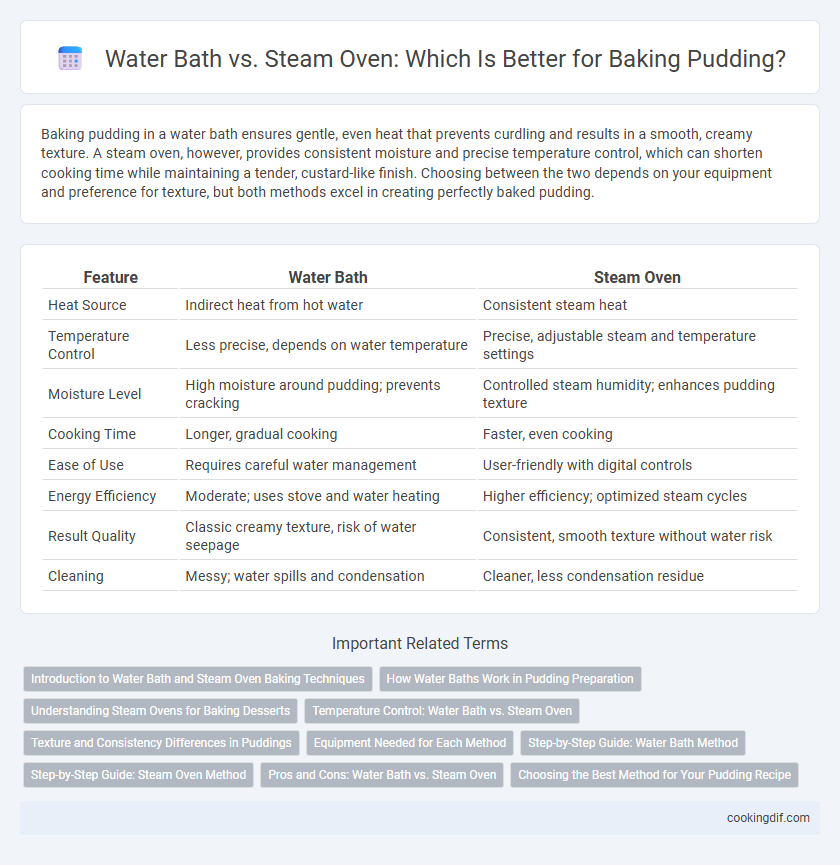Baking pudding in a water bath ensures gentle, even heat that prevents curdling and results in a smooth, creamy texture. A steam oven, however, provides consistent moisture and precise temperature control, which can shorten cooking time while maintaining a tender, custard-like finish. Choosing between the two depends on your equipment and preference for texture, but both methods excel in creating perfectly baked pudding.
Table of Comparison
| Feature | Water Bath | Steam Oven |
|---|---|---|
| Heat Source | Indirect heat from hot water | Consistent steam heat |
| Temperature Control | Less precise, depends on water temperature | Precise, adjustable steam and temperature settings |
| Moisture Level | High moisture around pudding; prevents cracking | Controlled steam humidity; enhances pudding texture |
| Cooking Time | Longer, gradual cooking | Faster, even cooking |
| Ease of Use | Requires careful water management | User-friendly with digital controls |
| Energy Efficiency | Moderate; uses stove and water heating | Higher efficiency; optimized steam cycles |
| Result Quality | Classic creamy texture, risk of water seepage | Consistent, smooth texture without water risk |
| Cleaning | Messy; water spills and condensation | Cleaner, less condensation residue |
Introduction to Water Bath and Steam Oven Baking Techniques
Water bath baking involves placing pudding containers in a larger pan filled with hot water, ensuring gentle and even heat distribution to prevent curdling and achieve a smooth, creamy texture. Steam oven baking uses saturated steam at controlled temperatures, which maintains moisture and produces consistent results with delicate desserts like custards and puddings. Both techniques optimize moisture retention and texture, but steam ovens offer precise humidity control, while water baths are simpler to set up with conventional ovens.
How Water Baths Work in Pudding Preparation
Water baths create a gentle and even heat by surrounding the pudding dish with hot water, preventing the edges from cooking faster than the center. This method ensures consistent temperature control, resulting in a smooth, creamy texture without curdling or cracking. The steam oven, while efficient, may not provide the same uniform moisture environment crucial for delicate pudding custards.
Understanding Steam Ovens for Baking Desserts
Steam ovens provide precise humidity control that enhances the texture and moisture of baked desserts like puddings by creating a consistent, moist environment. Unlike water baths, steam ovens eliminate the need for a separate water container, reducing preparation time and improving temperature accuracy. This method prevents curdling and promotes even cooking, resulting in smooth, creamy puddings with a delicate finish.
Temperature Control: Water Bath vs. Steam Oven
Water baths provide precise, consistent temperature control by surrounding the pudding with gently heated water, preventing overheating and curdling. Steam ovens maintain stable humidity and temperature with steam injection, ensuring even cooking and a smooth texture without drying out the pudding. Both methods excel at temperature regulation, but water baths offer more gradual temperature changes ideal for delicate custards.
Texture and Consistency Differences in Puddings
Water baths provide gentle, even heat, resulting in smooth, creamy puddings with consistent texture throughout. Steam ovens maintain high humidity and stable temperature, producing puddings that are moist and tender but with a slightly firmer outer layer. The choice between water bath and steam oven influences the pudding's overall creaminess and surface texture, affecting the final mouthfeel.
Equipment Needed for Each Method
Water bath baking requires a large roasting pan or baking dish filled with hot water, along with ramekins or pudding molds to hold the custard mixture securely without water infiltration. A steam oven, designed specifically for steam cooking, eliminates the need for additional water pans by generating controlled steam internally, providing consistent and even moisture distribution directly to the pudding. Unlike a traditional oven setup, steam ovens require specialized equipment with precise humidity controls, ensuring optimal texture for delicate puddings.
Step-by-Step Guide: Water Bath Method
The water bath method for baking pudding involves placing the pudding dish inside a larger pan filled with hot water to ensure even cooking and prevent cracking. Begin by preheating the oven to the desired temperature, then fill a roasting pan halfway with hot water before carefully placing the pudding dish inside. Bake until the pudding is set yet still slightly jiggly in the center, ensuring a smooth, creamy texture throughout.
Step-by-Step Guide: Steam Oven Method
Using a steam oven for baking pudding ensures even moisture distribution, preventing cracking and creating a silky texture. Begin by preheating the steam oven to 85degC (185degF), pour the pudding mixture into heatproof ramekins, and place them in the oven without covering. Steam bake for 40-50 minutes, checking for firmness by gently shaking the ramekins, then cool before serving to achieve the perfect creamy consistency.
Pros and Cons: Water Bath vs. Steam Oven
A water bath provides gentle, consistent heat that prevents pudding from curdling and ensures smooth, creamy texture, but it requires careful monitoring and can be messy. Steam ovens maintain precise humidity levels that help retain moisture and speed up baking time, though they can be more expensive and less accessible than traditional water baths. Choosing between them depends on desired texture control, convenience, and available kitchen equipment.
Choosing the Best Method for Your Pudding Recipe
Choosing the best method for baking pudding depends on the desired texture and moisture level; a water bath provides gentle, even heat that prevents cracking and results in a smooth, creamy consistency, especially ideal for custard-based puddings. Steam ovens maintain a humid environment that speeds up cooking while preserving moisture, yielding a tender pudding with a slightly different texture and often less dense than a water bath. For traditional recipes emphasizing delicate structure, a water bath remains preferred, while steam ovens suit quicker preparation and maintain moisture without the risk of water exposure.
Water bath vs Steam oven for baking Infographic

 cookingdif.com
cookingdif.com